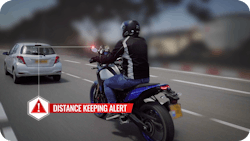Dec. 3, 2020—Motorcycle enthusiasts Uri Lavi and Lior Cohen founded Ride Vision in 2018 with the sole mission “to save riders’ lives.” Just two years later, the company created the world’s first collision-aversion technology for motorcycles.
The AI-based system functions with two wide-angle cameras, each with 360 degrees of visibility, a Predictive Vision algorithm, a compact in-unit computer processor, and two mirror-mounted LED alerts. Ride Vision’s Predictive Vision algorithm utilizes the cameras to identify critical threats to the rider.
FenderBender spoke with Lavi, co-founder and CEO of Ride Vision.
How does Ride Vision technology work?
Ride Vision uses a combination of image-recognition and AI technologies to power its solution, the first of its kind. The company’s patented human-machine warning interface (HMI) and predictive vision algorithms help riders make critical life-saving decisions in real time.
The hardware includes two wide-angle cameras mounted on both the front and rear of the vehicle, unique alert indicators placed on the mirrors, and an onboard main computing unit that stores Ride Vision’s patented algorithms.
What is collision-aversion technology?
Collision-aversion technology is aimed at preventing and avoiding collisions, as opposed to technologies that mitigate the damage from collisions.
How does collision-avoidance differ between motorcycles and cars?
Collision avoidance technologies for the automotive industry are not new, but until now, motorcycles haven't been privy to take advantage of similar technology, even though their proportion of fatal road accidents is very high.
Accounting for the tilt of the bike and rider behavior, such as riding between lanes and cars, makes the task of a machine recognizing danger a qualitatively different task than it is for cars.
Why are motorcycles often left out of the conversation when it comes to safety alert systems?
Motorcycles are quick and agile. They lean, maneuver quickly on the road, and sometimes even navigate between other vehicles. Their lightweight builds and nimble maneuvering mean they experience greater effects of physical force and roadway vibrations.
Even basic navigating in traffic requires a rider to shift their motorcycle’s weight from side to side as well as from front to back when braking and accelerating. This is why radar-based, or other car solutions, haven’t been able to solve the problem for two-wheelers.
Does Ride Vision work on any motorcycle?
Yes, Ride Vision can be installed on any kind of two or three-wheeler no matter what brand, model or year of release.
How much does Ride Vision cost?
The upfront cost is $360, with an additional $20 monthly subscription payment to get news alerts and extra features we are working on for 2021, like emergency call, Rear-Collision Alert, Front-Sides Collision Alert, special video editors, riding reports, and more.
How is a motorcycle outfitted with Ride Vision?
Installing Ride Vision is done by certified installers or in the dealership before handing over the vehicle to the customer.
Are there any other companies working to implement crash-avoidance systems in motorcycles that you know of?
We have seen recent announcements by Ducati and BMW to use Bosch’s Adaptive Cruise Control systems to control the motorcycle while the adaptive cruise control is on.
Bosch’s system is radar-based and cannot operate in angles higher than 14 degrees, or alert the driver when approaching standing vehicles. Bosch’s system cannot be retrofitted to existing motorcycles and will only be available in super premium models, in very specific scenarios.
Responses have been edited for clarity.
